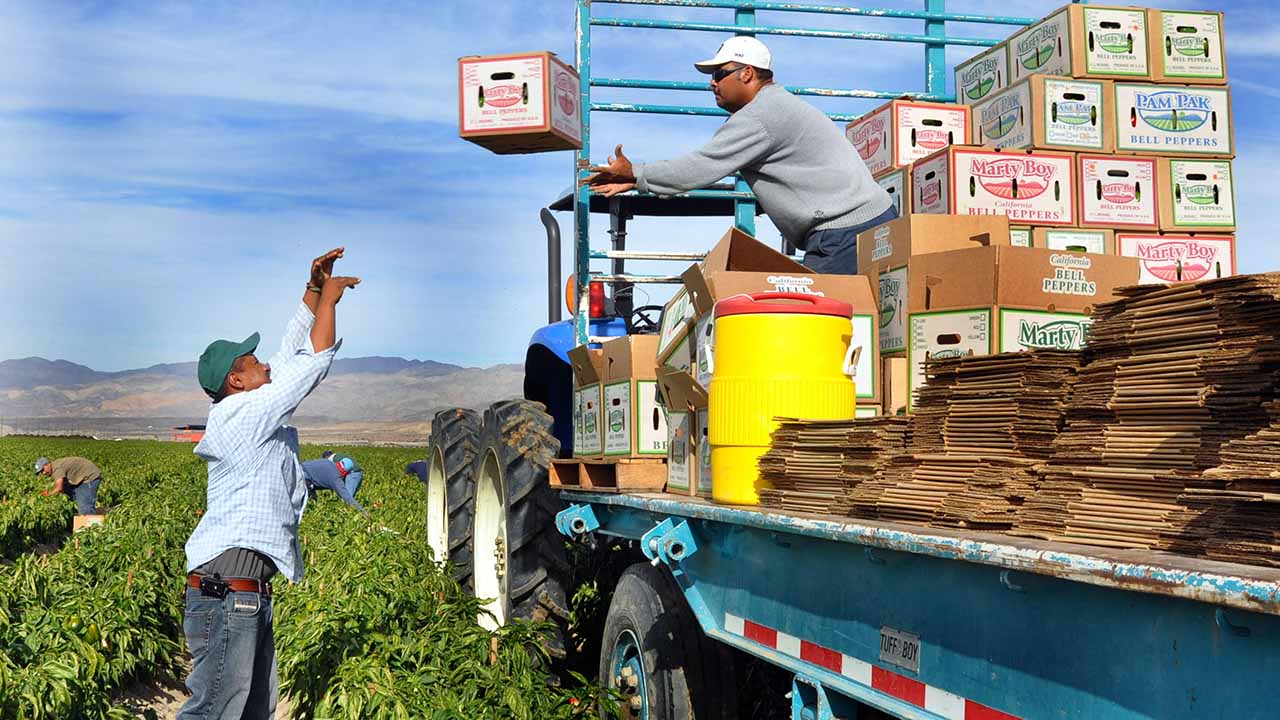
Farmworkers harvesting crops for Hidden Harvest (Photo courtesy of Hidden Harvest)
California Forward is committed to advancing policy intersections that create a more inclusive and sustainable California where all people can prosper. The Voices of Shared Prosperity series amplifies the stories of Californians who are committing their time and talent to solutions that embrace equity, environmental sustainability, and economic opportunity.
This year, we’re highlighting leaders who are making a difference in the Coachella Valley and Imperial Valley regions, leading up to the 2023 California Economic Summit taking place in Indian Wells on October 11-13.
The United States Department of Agriculture estimates nearly 30% of food grown on American farms are left in fields and never harvested. In the farm-rich Coachella Valley, that translates into millions of pounds of healthy produce that can go to food-insecure families and many of them are farmworker families. That’s why, nearly 24 years ago, Christy Porter started Hidden Harvest.
A former newspaper photographer, Porter used her love of gardening to help schools build vegetable gardens for the students. A chance conversation with a parent, who also happened to be a farmworker sparked the idea of a program to deliver unharvested produce to low-income communities.
Porter recalled, “The farmer asked me, ‘What’s wrong with this country? My wife and I work in the fields and my children go to school. But when my kids are not at school, we have to skip our meals on the weekend, so our kids have enough to eat. Yet, we’re surrounded by fantastic produce, healthy food, and we pick it, but we’re not allowed to pick what’s left behind.’”

She started talking to area farmers to figure out how to harvest the unwanted produce. They told her she needed to get a “couple of million dollars in liability” in case of any accidents during harvesting. She got the insurance, hired the same farmworkers who worked in those fields and, in their first crop, harvested 7,280 pounds of green beans.
“We started that way and we’ve averaged a million pounds of produce each year, harvested and given away in 25 years. We’re at about 30 million pounds,” said Porter. “It’s win-win because the farmworkers are also getting a living wage. It worked out.”
The harvested produce is free and distributed through Hidden Harvest’s Senior Market Program, the Personal Touch Program and the Healthy Fairs at school sites, which are chosen based on the percentage of students who qualify for free or reduced lunch. What makes these distributions special is that they are run much like farmers’ markets, where the participants are able to choose their produce. Hidden Harvest also serves 35,000-50,000 people each month by providing thousands of pounds of produce to local food banks and pantries as well as its Feeding America affiliate.
“The produce is in rolling carts and on tables and it emphasizes to the customer that it’s their choice,” explains Porter. “They pass through and they’re talking to each other and talking about recipes. Through congregate eating and sharing of food, they’re just talking constantly.”
Over the years, the region’s agriculture industry has changed. When Hidden Harvest started there were 70 farms. Today there are many fewer farms, but the acreage farmed has stayed about the same. That means more red tape to get to the unharvested food as well as a shift on where the food can be found. “The majority of the food now is in packing houses,” said Porter. Her team is often called to pick up excess produce that has already been picked and packed. “When you think about it, in the desert, refrigerated space is the most fancy real estate there is. So, they’re moving it out all the time and would just as soon throw it away as give it to me.” Even with this shift, she says they still rescue as much poundage or more than they ever have.
One of Hidden Harvest’s newest programs is the Small Farmers Pilot Project, geared toward farmers with one-to-two-acre farms. “They know how to grow things, but they don’t have the financial literacy to really sell their product,” said Porter. Hidden Harvest will pay the farmers a market wage to grow specific crops which will be given to families in need. The first farmer in the pilot project grew about 5,000 pounds of cauliflower and 9,000 pounds of broccoli. She added, “Now we have three sets of small farmers in various degrees of success. I know that this is the future of Hidden Harvest.”
Porter noted she is a Kentucky native and added, “My father was a coal miner. I’m a genuine coal miner’s daughter. We know what it’s like to grow your own food.” She moved west to be with her partner who was a Los Angeles Times reporter and joined as a photographer for the newspaper. Forty years later, she and her small crew (four in total) work to rescue unwanted produce and distribute it to those in need.
She sees other regions doing this work, but believes that Hidden Harvest is successful because the farmworkers are paid for their work (most organizations rely on volunteers). Also, she sees the Coachella Valley as the “perfect storm” of good, warm weather, available water (thanks to legacy water rights), enriched soil (the area was once an ocean floor), and access to labor. Porter often thinks about putting together a program to help other regions, but her current work takes up much of her time.
Porter also attributes Hidden Harvest’s success to its partners, “Without farmers helping us and opening their hearts to us, we couldn’t have done this at all. We love our farmers.”

